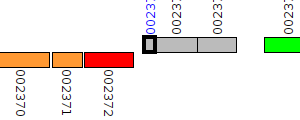In order to generate a more inclusive dataset of Pseudomonas genes mapped to putative in-paralogs and putative orthologs in other Pseudomonas species/strains, we developed a Pseudomonas Orthologous Groups classification system.
To generate ortholog groups, pair-wise DIAMOND searches were run on all genomes in the database to find reciprocal best hits (RBHs) for each gene. These analyses often resulted in multiple candidate genes for RBH status, which were narrowed down by examining the similarity between the query's flanking genes and the hit's flanking genes. If two candidate genes were directly adjacent, they where both accepted as RBHs that involve putative in-parology.
Pairwise intra-genome DIAMOND searches were also performed to acquire in-paralog information (i.e. gene duplications occurring after species divergence). If two genes in one genome were reciprocally more similar to each other than to any gene in the other genomes, the two genes were designated putative in-paralogs. Ortholog groups are built by starting with a seed gene and then adding all genes to which there is a RBH or in-paralog relationship.
Every new gene added to an ortholog group was then treated as a seed gene and the addition process was repeated until all qualifying genes had been added. The result was the development of orthologous groups, specifically generated for Pseudomonas species genomes, which can be used to sort search results.
Pseudomonas Ortholog Group POG004897
| Strain | Locus Tag | Description | Same-Strain Members | Fragment ? | |
|---|---|---|---|---|---|
| Pseudomonas fluorescens C1 | VC33_RS05395 |
cytochrome C
|
2 same-strain members: VC33_RS16105 VC33_RS05395 |

|
|
| Pseudomonas fluorescens C1 | VC33_RS16105 |
cytochrome
|
2 same-strain members: VC33_RS16105 VC33_RS05395 |

|
|
| Pseudomonas fluorescens C2 | NL64_RS18160 |
cytochrome
|
1 member |

|
|
| Pseudomonas fluorescens C3 | VC34_RS01085 |
cytochrome
|
1 member |

|
|
| Pseudomonas fluorescens EGD-AQ6 | O204_RS150200 |
cytochrome
|
1 member |

|
|
| Pseudomonas fluorescens F113 | PSF113_0038 |
protein Cmegm2
cmegm2 |
2 same-strain members: PSF113_0038 PSF113_3226 |

|
|
| Pseudomonas fluorescens F113 | PSF113_3226 |
cytochrome c5
|
2 same-strain members: PSF113_0038 PSF113_3226 |

|
|
| Pseudomonas fluorescens MEP34 | RU10_RS11110 |
cytochrome
|
1 member |

|
|
| Pseudomonas fluorescens PCL1751 | PF1751_RS00415 |
cytochrome
|
1 member |

|
|
| Pseudomonas fluorescens Pf0-1 | Pfl01_0054 |
cytochrome c-type protein
|
2 same-strain members: Pfl01_0054 Pfl01_2493 |

|
|
| Pseudomonas fluorescens Pf0-1 | Pfl01_2493 |
cytochrome c(mono-heme type)
|
2 same-strain members: Pfl01_0054 Pfl01_2493 |

|
|
| Pseudomonas fluorescens PICF7 | PFLUOLIPICF7_RS07775 |
cytochrome
|
1 member |

|
|
| Pseudomonas fluorescens Q2-87 | PflQ2_0057 |
cytochrome
|
2 same-strain members: PflQ2_0057 PflQ2_2063 |

|
|
| Pseudomonas fluorescens Q2-87 | PflQ2_2063 |
cytochrome C
|
2 same-strain members: PflQ2_0057 PflQ2_2063 |

|
|
| Pseudomonas fluorescens R124 | I1A_002373 |
cytochrome C
|
2 same-strain members: I1A_000107 I1A_002373 |

|
|
| Pseudomonas fluorescens R124 | I1A_000107 |
cytochrome
|
2 same-strain members: I1A_000107 I1A_002373 |

|
|
| Pseudomonas fluorescens SF39a | NX10_RS02905 |
cytochrome
|
1 member |

|
|
| Pseudomonas fluorescens SF4c | QS95_RS01185 |
cytochrome
|
2 same-strain members: QS95_RS01185 QS95_RS25600 |

|
|
| Pseudomonas fluorescens SF4c | QS95_RS25600 |
cytochrome C
|
2 same-strain members: QS95_RS01185 QS95_RS25600 |

|
|
| Pseudomonas fluorescens UK4 | HZ99_RS17825 |
hypothetical protein
|
1 member |

|